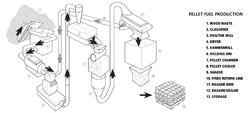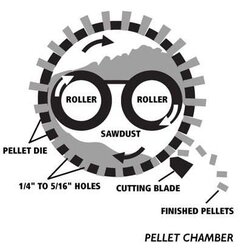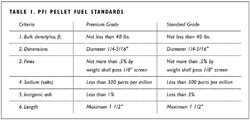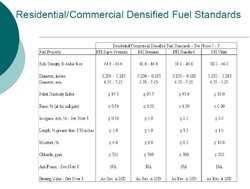Hello
Good Information from the Hearth Stone Heritage Pellet Stove Manual
Softwoods, hardwoods, and blends of different species are used as raw materials and known as feed
stock. Where hardwoods are generally the preferred species for cordwood appliances because of their
higher Btu content and lower emissions, pellets from softwoods generally have slightly higher caloric
value and lower ash content than pellets produced from hardwoods, particularly hardwoods containing
bark. Resins in softwoods that are more difficult to burn in a cordwood appliance are not a problem in
pellet appliances, which regulate the air for combustion and provide precise, gradual fuel feed in small
amounts.
Raw material particle size ranges from fine sawdust to large chips that must be ground to uniform size.
Careful handling of raw materials before the pelletizing process is important in reducing unwanted
foreign materials.
1.2 MANUFACTURING PROCESS
The production of pellet fuel begins with the raw materials, or feed stock. Contaminants must be
removed by using magnets to remove iron and classifiers to remove stones and non-magnetic metals.
Classifiers, also known as scalpers, are devices which employ air flow to move and separate the lighter
wood particles from heavier unwanted materials. Storage facilities and methods for managing feed stock
materials are determined by the moisture content of the materials; dry materials must be protected from
the elements, and green materials must be processed in timely fashion to prevent microbiological
deterioration. After storage, feed stock is pulverized and screened into small uniform pieces by hammer
mills and grinders and conveyed to holding bins or silos. A cyclone process of swirling air collects the
lighter fines, or dust, for use as dryer fuel.
In the case of green materials, the next step is the drying process. The most commonly used type of
dryer is the rotary dryer, a large revolving drum (some more than 10 feet in diameter and 40 feet long)
which continually lifts and tumbles the material through a hot gas stream. The drying process is
regulated by a variable rate feed screw and by control instruments which measure and match heat input
to demand. Uniform moisture is also achieved by the larger, wetter, heavier particles moving more
slowly through the drum than finer, drier, lighter particles. Dryers are often fired by using a portion
(about 8 to 10%) of the feed stock, mainly the fines, or smallest particles (also known as wood flour).
The drying process generally reduces incoming moisture content (wet basis, see following) of 40-45% to
6-10%.
The dried materials are conveyed to the conditioning chamber where steam may be
added to lubricate the materials and to help soften the natural lignens that act as a
bonding agent to hold the pellets together. The materials (feedstock) go next to the
pelleting chamber where they are extruded, or pressed, through thousands of 1/4 to
5/16" diameter holes in a steel die 1.5 to 3.5 inches thick. This extrusion process heats
the newly formed pellets to temperatures approaching 250° F. The hot, still soft pellets
are conveyed to a cooler to achieve room temperatures and hardening. Dust and loose
fines are shaken off and recycled as the pellets proceed to be bagged.
Does anyone see anything missing here?
Looks like the only difference between Standard Grade and Premium Grade Pellets is the ash content.
Good Information from the Hearth Stone Heritage Pellet Stove Manual
Softwoods, hardwoods, and blends of different species are used as raw materials and known as feed
stock. Where hardwoods are generally the preferred species for cordwood appliances because of their
higher Btu content and lower emissions, pellets from softwoods generally have slightly higher caloric
value and lower ash content than pellets produced from hardwoods, particularly hardwoods containing
bark. Resins in softwoods that are more difficult to burn in a cordwood appliance are not a problem in
pellet appliances, which regulate the air for combustion and provide precise, gradual fuel feed in small
amounts.
Raw material particle size ranges from fine sawdust to large chips that must be ground to uniform size.
Careful handling of raw materials before the pelletizing process is important in reducing unwanted
foreign materials.
1.2 MANUFACTURING PROCESS
The production of pellet fuel begins with the raw materials, or feed stock. Contaminants must be
removed by using magnets to remove iron and classifiers to remove stones and non-magnetic metals.
Classifiers, also known as scalpers, are devices which employ air flow to move and separate the lighter
wood particles from heavier unwanted materials. Storage facilities and methods for managing feed stock
materials are determined by the moisture content of the materials; dry materials must be protected from
the elements, and green materials must be processed in timely fashion to prevent microbiological
deterioration. After storage, feed stock is pulverized and screened into small uniform pieces by hammer
mills and grinders and conveyed to holding bins or silos. A cyclone process of swirling air collects the
lighter fines, or dust, for use as dryer fuel.
In the case of green materials, the next step is the drying process. The most commonly used type of
dryer is the rotary dryer, a large revolving drum (some more than 10 feet in diameter and 40 feet long)
which continually lifts and tumbles the material through a hot gas stream. The drying process is
regulated by a variable rate feed screw and by control instruments which measure and match heat input
to demand. Uniform moisture is also achieved by the larger, wetter, heavier particles moving more
slowly through the drum than finer, drier, lighter particles. Dryers are often fired by using a portion
(about 8 to 10%) of the feed stock, mainly the fines, or smallest particles (also known as wood flour).
The drying process generally reduces incoming moisture content (wet basis, see following) of 40-45% to
6-10%.
The dried materials are conveyed to the conditioning chamber where steam may be
added to lubricate the materials and to help soften the natural lignens that act as a
bonding agent to hold the pellets together. The materials (feedstock) go next to the
pelleting chamber where they are extruded, or pressed, through thousands of 1/4 to
5/16" diameter holes in a steel die 1.5 to 3.5 inches thick. This extrusion process heats
the newly formed pellets to temperatures approaching 250° F. The hot, still soft pellets
are conveyed to a cooler to achieve room temperatures and hardening. Dust and loose
fines are shaken off and recycled as the pellets proceed to be bagged.
Does anyone see anything missing here?
Looks like the only difference between Standard Grade and Premium Grade Pellets is the ash content.





